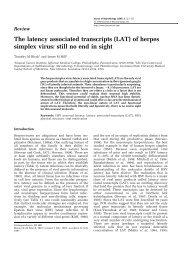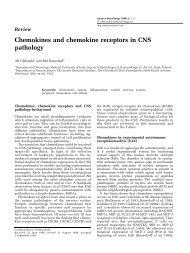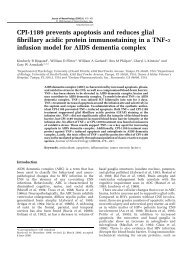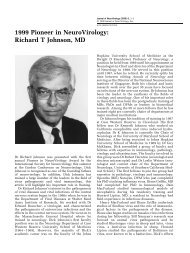Localization of retrovirus in the central nervous system of a patient ...
Localization of retrovirus in the central nervous system of a patient ...
Localization of retrovirus in the central nervous system of a patient ...
You also want an ePaper? Increase the reach of your titles
YUMPU automatically turns print PDFs into web optimized ePapers that Google loves.
62<br />
HIV and HTLV-1 co-<strong>in</strong>fection<br />
MC Lev<strong>in</strong><br />
(Rosenblum et al, 1992). Autopsy showed bra<strong>in</strong><br />
atrophy and HIV-1 encephalitis con® rmed by<br />
positive HIV-1 p24 cells. The sp<strong>in</strong>al cord showed<br />
nonvacuolar myelopathy with axonal loss and<br />
demyel<strong>in</strong>ation. Initial retroviral analysis for HIV<br />
and HTLV-1 by ISH was negative. Solution phase<br />
PCR <strong>of</strong> bra<strong>in</strong> showed HTLV-1 speci® c signal<br />
(Rosenblum et al, 1992).<br />
In this study, a comb<strong>in</strong>ation <strong>of</strong> immunocytochemistry,<br />
ISH and PCR/ISH were used to detect<br />
HIV and HTLV-1 and co-localize it to speci® c cell<br />
phenotypes <strong>in</strong> formal<strong>in</strong> ® xed, paraf® n embedded<br />
CNS and control tissues. For those experiments<br />
requir<strong>in</strong>g immunocytochemistry, it was performed<br />
® rst under RNASE free conditions. Primary antibodies<br />
<strong>in</strong>cluded: HAM-56 (Enzo Biochemical Co.,<br />
New York, NY, USA) for macrophage/microglia and<br />
glial ® brillary acidic prote<strong>in</strong> (GFAP) (Dako, Carp<strong>in</strong>teria,<br />
CA, USA) for astrocytes. Biot<strong>in</strong>ylated secondary<br />
antibodies (Vector, Burl<strong>in</strong>game, CA, USA) were<br />
used to detect primary antibodies. The antigenantibody-biot<strong>in</strong><br />
complex was conjugated to avid<strong>in</strong><br />
(ABC solution, Vector) and detected with a diam<strong>in</strong>obenzid<strong>in</strong>e<br />
(DAB) peroxide <strong>system</strong> <strong>in</strong> which<br />
positive sta<strong>in</strong><strong>in</strong>g is brown or by new fuchs<strong>in</strong> (Dako)<br />
<strong>in</strong> which positive sta<strong>in</strong><strong>in</strong>g is red.<br />
For HIV ISH, a full length HIV-1 LA1 cRNA probe<br />
( 35 S-dCTP, 2 ´ 10 6 d.p.m./ul, alkal<strong>in</strong>e hydrolyzed)<br />
was used <strong>in</strong> <strong>the</strong> anti-sense con® guration to detect<br />
HIV-RNA. A HIV <strong>in</strong>fected cell l<strong>in</strong>e (H-9) was used as<br />
positive control. For HTLV-1-RNA ISH, an antisense<br />
2.1 kb cRNA probe ( 35 S-dCTP, 2 ´ 10 6 d.p.m./<br />
ul, alkal<strong>in</strong>e hydrolyzed) <strong>of</strong> HTLV-1-tax was used.<br />
To detect HTLV-1-DNA, PCR/ISH with HTLV-1-tax<br />
speci® c primers were used to amplify HTLV-1 tax<br />
(Lev<strong>in</strong> et a l, 1996). Follow<strong>in</strong>g PCR, ISH was<br />
performed us<strong>in</strong>g <strong>the</strong> sense HTLV-1-tax probe to<br />
detect ampli® ed DNA. An HTLV-1<strong>in</strong>fected cell l<strong>in</strong>e<br />
(HUT-102) was used as a positive control. Un<strong>in</strong>fected<br />
peripheral blood lymphocytes (PBL) and<br />
normal CNS tissues were used for negative controls.<br />
Follow<strong>in</strong>g ISH, autoradiograms were prepared with<br />
photographic emulsion (Kodak). Slides were developed<br />
after ® ve days and countersta<strong>in</strong>ed with<br />
hematoxyl<strong>in</strong> and/or eos<strong>in</strong>.<br />
Conventional ISH with <strong>the</strong> antisense 35 S-labeled<br />
HTLV-1-tax probe was used to detect HTLV-1-tax<br />
RNA (Table 1). In HUT 102 cells (an HTLV-1<br />
<strong>in</strong>fected cell l<strong>in</strong>e that expresses multiple copies <strong>of</strong><br />
HTLV-1-RNA), <strong>the</strong>re was <strong>in</strong>tense silver gra<strong>in</strong><br />
localization (Figure 1a). There was no speci® c<br />
signal <strong>in</strong> un<strong>in</strong>fected PBL (Figure 1b) or <strong>in</strong> normal<br />
Table 1 Detection <strong>of</strong> HTLV-1 and HIV <strong>in</strong> normal and<br />
<strong>retrovirus</strong>-<strong>in</strong>fected tissues<br />
HTLV-1<br />
HIV<br />
Ð Ð<br />
Ð Ð<br />
Ð<br />
Ð<br />
Un<strong>in</strong>fected PBL ( ) ( )<br />
HTLV-1 (+) HUT 102 cells (+) RNA and DNA nd<br />
HIV (+) H9 cells nd (+)<br />
Normal, un<strong>in</strong>fected CNS ( ) ( )<br />
Dual (HTLV-1/HIV) <strong>in</strong>fected CNS (+) (+)<br />
GFAP positive astrocytes (+) RNA and DNA ( )<br />
Macrophage/microglia ( ) (+)<br />
nd, not done.<br />
Figure 1 ISH for HTLV-1-tax-RNA with <strong>the</strong> antisense 35 -S HTLV-1-tax probe (magni® cation 400 ´ , hematoxyl<strong>in</strong> and eos<strong>in</strong><br />
countersta<strong>in</strong> except where noted). (a) positive control, HUT-102 cells. Intense silver gra<strong>in</strong> localization <strong>in</strong> all cells; (b) negative control,<br />
un<strong>in</strong>fected PBL. No signal present with<strong>in</strong> cells; (c) normal bra<strong>in</strong>. No speci® c signal present; (d) dual <strong>in</strong>fected bra<strong>in</strong>. Multiple HTLV-1-<br />
tax-RNA positive cells are present; (e) dual <strong>in</strong>fected bra<strong>in</strong> sta<strong>in</strong>ed with GFAP (p<strong>in</strong>k) and countersta<strong>in</strong>ed with hematoxyl<strong>in</strong> only. HTLV-<br />
1-tax-RNA (silver gra<strong>in</strong>s) co-localized to a GFAP positive astrocyte (p<strong>in</strong>k).








